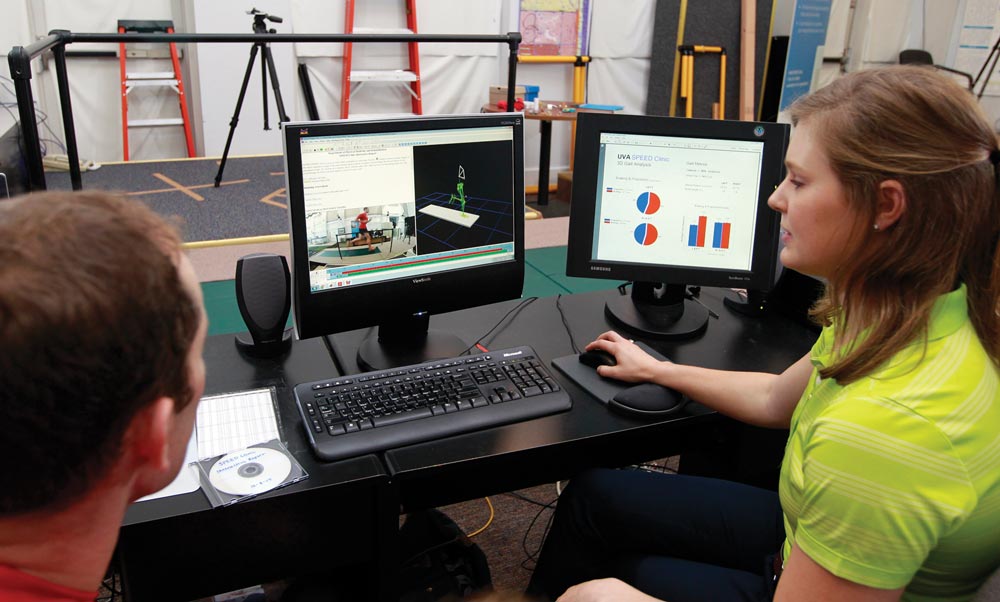Better, Stronger, Faster
UVA’s SPEED Clinic uses high-tech wizardry to help weekend warriors
My husband, Matt Clay (Educ ’02), is a former UVA baseball player. He works out six days a week: biking, running, yoga, P90X. In other words, when he’s not on daddy duty or teaching Latin at Albemarle High School, he’s a jock. But as he’s gotten older, he’s found himself dealing with the usual aches and pains that come with age. Especially when he decides to pound the pavement for a few miles.

But when he heard about UVA’s SPEED Clinic (SPEED for Strength, Power, Endurance, Education and Development), he was intrigued. An opportunity to have his gait, stride and body positioning analyzed by professionals? A chance to run better, faster, stronger—and pain free? “Sign me up,” he said.
I’m not sure what we were expecting to see when we got there, but the SPEED Clinic, located in the basement of a building in UVA’s Fontaine Research Park, is in a former cafeteria. Don’t let appearances fool you—it was the first place in the world to offer instrumented 3-D gait analysis. The green treadmill, a one-of-a-kind prototype, is a 6,000-pound monster built by an adjunct professor.
Roughly two dozen people visit the clinic each month to have SPEED Clinic director Max Prokopy (Educ ’08) and his staff analyze their running gait or golf or tennis swings. Prokopy says that it isn’t uncommon for clients to see improvement right away. “I’ve gotten emails from folks who set personal records within a week of seeing us,” he says.
After taking Matt’s basic measurements and entering the numbers into the computer, Prokopy and an analyst create a digital animation of Matt’s body. SPEED staff then tape 17 sensors onto Matt’s shoes, legs, back and feet. “I feel like I’m in a video game,” Matt says.
Stationed throughout the room are 12 infrared cameras as well as two GoPro digital cameras. Prokopy has Matt stand on the treadmill to walk and then run for 5 minutes, as Prokopy jots down notes on a clipboard.
Then the SPEED team flips on the cameras and has Matt run for another 90 seconds. “I’ve never been so self-conscious of how I’m moving,” Matt says.
After the run, Matt fills out a detailed questionnaire, covering areas like training history, competition, injuries and goals. Prokopy and Matt discuss the topics, particularly Matt’s past injuries, then Matt is asked to complete a set of lunges, squats and other exercises. Prokopy notices that Matt has “Morton’s foot” on his left side, a common disorder in which the big toe muscles are shorter than the second toe muscles.
“That means you’re always wanting to turn that left toe out,” Prokopy explains. Prokopy later shows Matt exercises to adjust for the overcompensation.
Next, we walk over to the computer to see video-game-Matt. His 3-D figure runs, with arrows at the point of impact indicating ground reaction forces. Prokopy’s assistant, Leigh Allin, explains the graphs, how Matt’s movements aren’t quite mirroring those of a healthy runner.
Matt’s results, Prokopy says, are typical of what he and his team often see: poor core stability, weak gluteus muscles and tight ankles, which leads to overstriding and overbraking as well as extra stress on the body. With golfers, Prokopy reports that they usually also find tightness in the middle and spine, which leads to compensated swing faults.

Prokopy shows Matt several exercises that will help him build different muscles to improve his gait while also preventing injuries. We wrap up by going outside and watching Matt run a few sprints with some of Prokopy’s recommendations in mind. Matt already sees improvement. All told, the visit took about two and a half hours.
A few days later, Matt went for his first post-SPEED run. After going through the exercises Prokopy gave him, Matt ran faster and with significantly less pain. “I really focused on using my glutes more and it felt much better,” Matt said. Looks like faster, competitive runs can be added to his workout list.